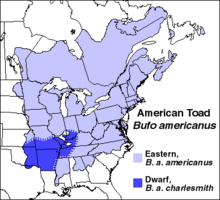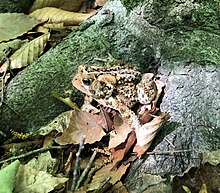American toad
| American toad | |
|---|---|

| |
| Specimen from Jacques-Cartier National Park, Quebec, Canada | |
| Scientific classification | |
| Domain: | Eukaryota |
| Kingdom: | Animalia |
| Phylum: | Chordata |
| Class: | Amphibia |
| Order: | Anura |
| Family: | Bufonidae |
| Genus: | Anaxyrus |
| Species: | A. americanus
|
| Binomial name | |
| Anaxyrus americanus (Holbrook, 1836)
| |
| Subspecies | |
| |

| |
| Range of A. americanus | |
| Synonyms | |
|
Bufo americanus Holbrook, 1836 | |
The American toad (Anaxyrus americanus)[3] is a common species of toad found throughout Canada and the eastern United States. It is divided into three subspecies: the eastern American toad (A. a. americanus), the dwarf American toad (A. a. charlesmithi) and the rare Hudson Bay toad (A. a. copei). Recent taxonomic treatments place this species in the genus Anaxyrus instead of Bufo.[3][4][5]
Eggs
A. americanus eggs are bicolored. They are often a roughly equal mixture of a black or brown with white or cream. The eggs are deposited in two long ropes that have been recorded to transcend 60 m in length. Single egg diameter ranges from 0.1 cm to 0.2 cm.[6]
Tadpoles

The American toad lays between 2,000-20,000 eggs in two strings and can hatch in 3-12 days.
Tadpoles have several mechanisms to reduce predation.[10] They avoid predators by swimming in very shallow water often with thick grass vegetation, and by swimming close together in schools during the day. Tadpoles also produce toxic chemicals in their skin that discourage some potential predators. Fish have been reported to die after consuming one tadpole; however, most fish quickly learn to avoid eating American toad tadpoles. The tadpoles are also very small and they are a solid black color.[11]
Biogeography
Based on DNA sequence comparisons, Anaxyrus americanus and other North American species of Anaxyrus are thought to be descended from an invasion of toads from South America prior to the formation of the Isthmus of Panama land bridge, presumably by means of rafting.[12]
Subspecies
Races tend to
Eastern American toad




The eastern American toad (A. a. americanus) is a medium-sized toad usually ranging in size from 5–9 cm (2.0–3.5 in);[13] the record length for an eastern American toad is 11.1 cm (4.4 in).[14] The color and pattern is somewhat variable, especially for the females. Skin color can change depending on habitat colors, humidity, stress, and temperature. Color changes range from yellow to brown to black, from solid colors to speckled. Their breeding habits are very similar to Anaxyrus fowleri. The call or voice of a breeding male is a high trill that lasts between 6–30 seconds[14] and sounds similar to a ringing telephone. Males call for an average of 6-7 nights during their breeding period.[15] Females show preference for call efforts (rate × duration), but not call frequency.[16] They hibernate during the winter. The eastern American toad has spots that contain only one to two warts. It also has enlarged warts on the tibia or lower leg below the knee. While the belly is usually spotted, in some areas many are, and it is generally more so on the forward half (in some rare individuals there may be few or no spots). This subspecies of the American toad has no or very little markings on it. The spades on the back legs are blackish. Some toads of this subspecies have a more pervasive red and deep brown color, many with red warts on their bodies. Also eastern American toads have parotoid glands that are the same color as the surrounding skin. The glands don't usually have any patterning on them.
Other species that may be confused with the eastern American toad are
American toads require a semi-permanent freshwater pond or pool with shallow water in which to breed, to gather their water supplies in times of drought or as a routine,[14] and for their early development. They also require dense patches of vegetation, for cover and hunting grounds. Given these two things and a supply of insects for food, American toads can live almost everywhere, ranging from forests to flat grassland. Females when caught are silent and easily tamed, adapting to terrarium life readily, while the smaller males are readily communicative. The smaller males do not adapt well to terrarium life and should be released after a few days of observation.[original research?] Adult toads are mostly nocturnal, although juveniles are often abroad by day. When it rains, these toads will become active and can be observed eating robustly worms and insects leaving their burrows and walking in front of an opportunist toad. These toads are 'creatures of habit' once they have a certain area they prefer to live within... an acre of wooded forest with water in proximity for soaking, a home with cool ledges and window wells; they commonly seek cover in burrows, under boardwalks, flat stones, boards, logs, wood piles, or other cover. When cold weather comes, these toads dig backwards and bury themselves in the dirt of their summer homes, or they may choose another site in which to hibernate.[11] Their diet includes crickets, mealworms, earthworms, ants, spiders, slugs, centipedes, moths, and other small invertebrates. Some of these toads have been known to live over 30 years and currently a female specimen (over 13 centimeters long) is living healthily into her late 30s. Another female toad of 17 centimeters is known to have existed in Wisconsin from Washington Island on Lake Michigan.
The eastern American toad may be confused with the Canadian toad in the area where they overlap, but the cranial crests in the American toad do not join to form a raised "boss" (bump) like they do in the Canadian toad. Its range also overlaps with the southern toad's, but in this species the cranial crests form two unique knobs.
Dwarf American toad
The dwarf American toad (A. a. charlesmithi), is a smaller version of the American toad, which reaches lengths of about 6 cm (2+1⁄4 in), is generally a dark reddish color ranging to light red in some specimens in isolated populations. The spots on the back are reduced or absent, and when present they contain a few small red warts and a black ring around it like in the normal American toad. The warts are always darker than the skin of the toad. Some specimens have a white dorsal line in the middle of their backs. The ventral surface or belly is usually cream colored with a few dark spots in the breast area. This subspecies can be distinguished from the above-mentioned species in the same manner as for the eastern American toad. The southwestern portion of the Dwarf American toad's range overlaps with that of the
Hudson Bay toad
The Hudson Bay toad (A. a. copei) is a rare Canadian subspecies of A. americanus.[19] This subspecies of the American toad has been seen in the northern parts of Ontario where there are a few isolated populations. These northern dwarf toads mostly have the red coloring on the sides of their bodies and have an unusually high number of warts for the subspecies. Interbreeding with eastern American toads caused this subspecies to lose the red coloring on their backs.
Inbreeding avoidance
Toads display breeding site fidelity, as do many other amphibians. Individuals that return to natal ponds to breed will likely encounter siblings as potential mates. Although incest is possible, Anaxyrus americanus siblings rarely mate.[20] These toads likely recognize and actively avoid close kins as mates. Advertisement vocalizations by males appear to serve as cues by which females recognize their kin.[20]
Gallery
-
Newly metamorphosed American Toad (~5mm) at confluence of Keay Brook, Berwick, ME and the Salmon Falls River.
-
Approximately one week into adult cycle, shown in comparison to an adult female human hand
-
Eastern American toad, seen from behind, shows characteristic markings and "warts"
-
Closeup of the Eastern American toad
-
Young American toad
-
Front view of Eastern American toad
-
Side view of camouflaged A. americanus
-
Eastern American toad (A. a. americanus), North Dumfries, Ontario
-
American toad eating its skin as it sheds
-
American toad chirp - mating call
-
American toad feeding time
-
5 year old female American toad.
-
A closeup of an Eastern American toad seen in Tennessee.
See also
- European toad
- European green toad
- Japanese toad
References
- . Retrieved 19 November 2021.
- ^ "Anaxyrus americanus". NatureServe Explorer. Retrieved 17 April 2024.
- ^ a b Frost, Darrel R. (2015). "Anaxyrus americanus (Holbrook, 1836)". Amphibian Species of the World: an Online Reference. Version 6.0. American Museum of Natural History. Retrieved 23 December 2015.
- ^ Review: The Amphibian Tree of Life, by Frost, D.R. et al. Archived 2013-04-04 at the Wayback Machine, Amphibiatree
- ^ "Bufonidae". AmphibiaWeb: Information on amphibian biology and conservation. [web application]. Berkeley, California: AmphibiaWeb. 2015. Retrieved 23 December 2015.
- ISSN 2332-4961.
- ^ "Species Profile: American Toad (Bufo [Anaxyrus] americanus) | SREL Herpetology". srelherp.uga.edu. Retrieved 2024-04-24.
- ^ Tumlison, Renn; Trauth, Stanley E. (July 2006). "A novel facultative mutualistic relationship between bufonid tadpoles and flagellated green algae" (PDF). Herpetological Conservation and Biology. 1: 51–55.
- .
- ^ "ADW: Bufo americanus: Information". Animaldiversity.ummz.umich.edu. Retrieved 2011-04-01.
- ^ a b "University of Notre Dame: Yellow perch predation on tadpoles" (PDF). Retrieved 2011-04-01.
- S2CID 198155461.
- ^ American toad (Bufo americanus) Archived June 18, 2009, at the Wayback Machine, Natural Resources Canada
- ^ ISBN 0-395-19979-4.
- ISSN 0045-8511.
- ISSN 0045-8511.
- ^ Lannoo, Michael. "Amphibian Declines: The Conservation Status of United States Species". Amphibiaweb. Regents of the University of California. Retrieved 8 May 2019.
- ^ Vigil, Stacey; Mengak, Michael (October 2006). "American Toad (Bufo americanus)". WSFS Natural History Series. 7: 2–3.
- ^ "American toad". Frog Toad Newt and Salamander Species of Canada. amphibians.ca. Retrieved 17 August 2013.
- ^ .
External links
- B. americanus at the United States Geological Survey site
- USDA – Bufo americanus – United States Department of Agriculture Integrated Taxonomic Information System.
- Animal Diversity Web: Bufo americanus
- Photograph and audio recording of male American toad















